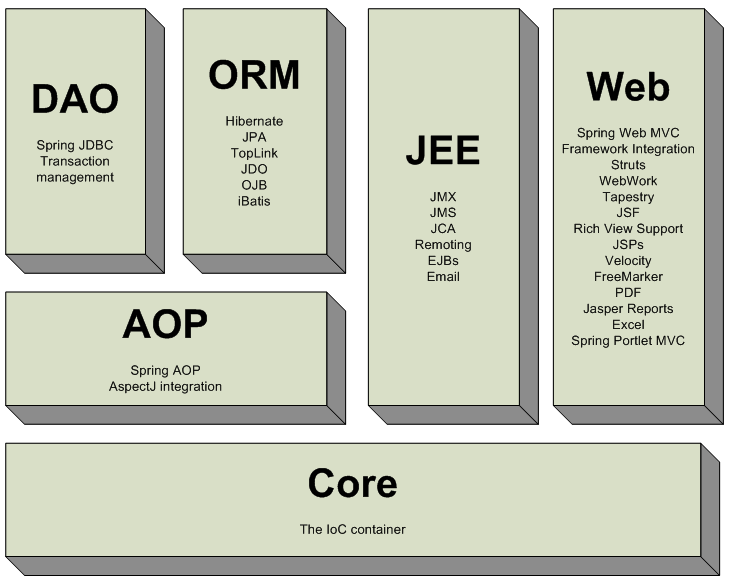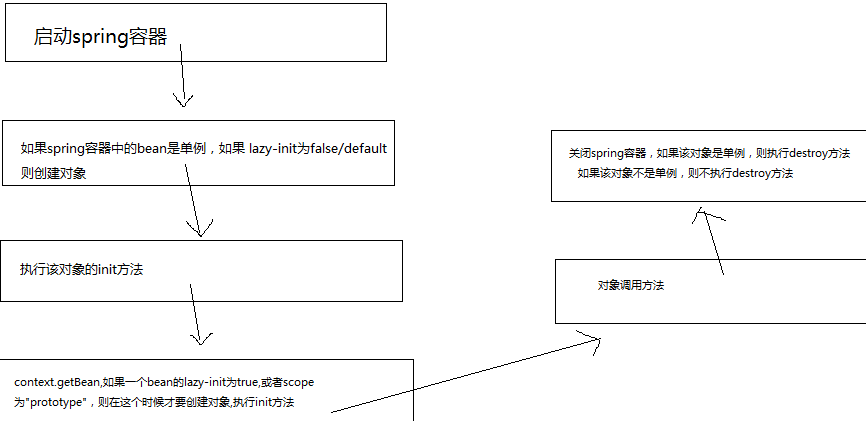1 Spring基本特征

Spring是一个非常活跃的开源框架;它是一个基于Core来构架多层JavaEE系统的框架,它的主要目地是简化企业开发.
Spring以一种非侵入式的方式来管理你的代码,Spring提倡”最少侵入”,这也就意味着你可以适当的时候安装或卸载Spring,Spring让java亮了。 (开放–闭合原理),这里是闭原则。
2 开发spring所需要的工具
(这里先将spring2.5 ,后面3.0)
2.1 Spring的jar包
到http://www.springsource.org/download下载spring,然后进行解压缩,在解压目录中找到下面jar文件,拷贝到类路径下
—spring的核心类库 在spring文档的dist下 dist\spring.jar
—引入的第三方类库 都spring文档的lib下,lib\jakarta-commons\commons-logging.jar
—如果使用了切面编程(AOP),还需要下列jar文件 lib/aspectj/aspectjweaver.jar和aspectjrt.jarlib/cglib/cglib-nodep-2.1_3.jar
—如果使用了JSR-250中的注解,如@Resource/@PostConstruct/@PreDestroy,还需要下列jar文件lib\j2ee\common-annotations.jar
注:JSR(Java 规范请求)是指向JCP(Java Community Process)提出新增一个标准化技术规范的正式请求。任何人都可以提交JSR(Java 规范请求),以向Java平台增添新的API和服务。JSR已成为Java界的一个重要标准
2.2 Spring配置文件
默认情况下是applicationContext.xml文件。可以建立很多xml文件,工程中一般都是这样配置的。(src目录下建)
3 Spring基本功能详解
3.1 SpringIOC
Spring的控制反转:把对象的创建、初始化、销毁等工作交给spring容器来做。由spring容器控制对象的生命周期。
步骤:
- A. 启动spring容器
1、 在类路径下寻找配置文件来实例化容器
ApplicationContext ctx = new ClassPathXmlApplicationContext(new String[]{"applicationContext.xml"});可以在整个类路径中寻找xml文件
* 通过这种方式加载。需要将spring的配置文件放到当前项目的classpath路径下
* classpath路径指的是当前项目的src目录,该目录是java源文件的存放位置。
2、 在文件系统路径下寻找配置文件来实例化容器
Spring的配置文件可以指定多个,可以通过String数组传入。
注:经常用第一种方法启动容器
- B. 从spring容器中提取对象
spring 容器结构:

3.2 别名
<beans>
<alias name="person" alias="p"/>//alias这里是别名,可以通过p,得到person这个bean.
<bean name="person" class="cn.itcast.aliasspring.Person"/>
</beans>通过这样的配置,可以达到在一个地方命名,在多个地方使用不同的名字的效果。
3.3 Spring容器内部对象
1 创建对象的方式
1.1 无参构造函数
<bean id="helloWorld" class="com.itheima10.spring.createobject.HelloWorld"></bean>
1.2 静态工厂方法
<bean id="helloWorld2" class="com.itheima10.spring.createobject.method.HelloWorldFactory"
factory-method="getInstance"></bean>1.3 实例工厂方法
<bean id="helloWorldFactory" class="com.itheima10.spring.createobject.method.HelloWorldFactory2"></bean>
<bean id="helloWorld3" factory-bean="helloWorldFactory" factory-method="getInstance"></bean>记住概念即可,用的最多的是第一种方法,但是和别的工具集成时,用的是实例工厂模式。
实例:
配置applicationContext.xml
<xml version="1.0" encoding="UTF-8">
<beans xmlns="http://www.springframework.org/schema/beans"
xmlns:xsi="http://www.w3.org/2001/XMLSchema-instance"
xsi:schemaLocation="http://www.springframework.org/schema/beans
http://www.springframework.org/schema/beans/spring-beans-2.5.xsd">
<!--
把一个类放入到spring容器中,该类就称为一个bean
-->
<!--
bean描述了一个类
id 唯一的标示
class 类的全名
-->
<bean id="helloWorld" class="com.itheima10.spring.createobject.HelloWorld"></bean>
<!-----------------------别名-------------------------------------->
<!--
name的属性和bean的id匹配
alias 别名
-->
<alias name="helloWorld" alias="狗蛋"/>
<alias name="helloWorld" alias="习近平"/>
<!-----------------------静态工厂方法-------------------------------------->
<!--
把helloWorldFactory放入到spring容器中
factory-method 工厂方法
-->
<bean id="helloWorld2"
factory-method="getInstance"
class="com.itheima10.spring.createobject.method.HelloWorldFactory"></bean>
<!-----------------------实例工厂方法-------------------------------------->
<!--
把helloWorldFactory2放入到spring容器中
factory-bean 指明了工厂bean
factory-method 指明了该工厂bean中的方法
-->
<bean id="helloWorldFactory" class="com.itheima10.spring.createobject.method.HelloWorldFactory2"></bean>
<bean id="helloWorld3"
factory-bean="helloWorldFactory"
factory-method="getInstance"></bean>
</beans>建立实体类HelloWorld
package com.itheima10.spring.createobject;
public class HelloWorld {
public void hello(){
System.out.println("hello");
}
}建立静态工厂HelloWorldFactory
package com.itheima10.spring.createobject.method;
public class HelloWorldFactory {
public static HelloWorld getInstance(){
System.out.println("static method");
return new HelloWorld();
}
}
建立实体工厂HelloWorldFactory2
package com.itheima10.spring.createobject.method;
public class HelloWorldFactory2 {
/**
* 必须先创建工厂对象,才能调用该方法
* @return
*/
public HelloWorld getInstance(){
return new HelloWorld();
}
}
编写测试方法CreateObjectMethodTest
package com.itheima10.spring.createobject.method;
import org.junit.Test;
import org.springframework.context.ApplicationContext;
import org.springframework.context.support.ClassPathXmlApplicationContext;
/**
* 第二种和第三种产生方式能看明白就OK了
* @author zd
*
*/
public class CreateObjectMethodTest {
/**
* 在默认情况下,spring容器调用的是一个类的默认的构造函数创建对象
*/
@Test
public void testCreateObject_Default(){
ApplicationContext context =
new ClassPathXmlApplicationContext("applicationContext.xml");
HelloWorld helloWorld = (HelloWorld)context.getBean("helloWorld");
helloWorld.hello();
}
/**
* 利用静态工厂创建对象
* <bean id="helloWorld2"
factory-method="getInstance"
class="com.itheima10.spring.createobject.method.HelloWorldFactory"></bean>
spring容器做的事情:
利用HelloWorldFactory类调用了getInstance方法
*/
@Test
public void testCreateObject_StaticFactory(){
ApplicationContext context =
new ClassPathXmlApplicationContext("applicationContext.xml");
HelloWorld helloWorld = (HelloWorld)context.getBean("helloWorld2");
helloWorld.hello();
}
/**
* 实例工厂方法创建对象
* <bean id="helloWorldFactory"
* class="com.itheima10.spring.createobject.method.HelloWorldFactory2"></bean>
* <bean id="helloWorld3"
factory-bean="helloWorldFactory"
factory-method="getInstance"></bean>
spring容器内部做的事情:
1、创建一个helloWorldFactory对象
2、由该对象调用getInstance产生helloWorld对象
*/
@Test
public void testCreateObject_InstanceFactory(){
ApplicationContext context =
new ClassPathXmlApplicationContext("applicationContext.xml");
HelloWorld helloWorld = (HelloWorld)context.getBean("helloWorld3");
helloWorld.hello();
}
}
2 对象的scope
对象的scope有两个属性:singleton 与prototype。singleton表示单例
2.1 singleton(默认值)
在每个Spring IoC容器中一个bean定义只有一个对象实例(共享)。
2.2 prototype
允许bean可以被多次实例化(使用一次就创建一个实例) . Spring不能对一个prototype bean的整个生命周期负责.这就意味着清楚prototype作用域的对象并释放任何prototype bean所持有的昂贵资源都是客户端的责任。
<bean id="helloWorld" class="com.itheima10.spring.scope.HelloWorld" scope="singleton"></bean>
<bean id="helloWorld" class="com.itheima10.spring.scope.HelloWorld" scope="prototype"></bean>建立HelloWorld类
public class HelloWorld {
public List<String> lists = new ArrayList<String>();
public HelloWorld(){
System.out.println("new instance");
}
public void hello(){
System.out.println("hello");
}
}建立测试类ScopeTest
package com.itheima10.spring.scope;
import org.junit.Test;
import org.springframework.context.ApplicationContext;
import org.springframework.context.support.ClassPathXmlApplicationContext;
public class ScopeTest {
/**
* 把一个bean放入到spring容器中,默认的是单例
* 如果一个类放入到spring容易中,而这个类是单例的,那么该类中的属性将会成为共享的
*/
@Test
public void testCreateObject_Scope_Default(){
ApplicationContext context =
new ClassPathXmlApplicationContext("applicationContext.xml");
HelloWorld hello1 = (HelloWorld)context.getBean("helloWorld");
hello1.lists.add("aaaa");
hello2= (HelloWorld)context.getBean("helloWorld");
hello2.lists.add("bbbb");
System.out.println(helloWorld.lists.size());//2,并且只输出一次new instance
}
/**
* 如果spring的配置文件如下:
* <bean id="helloWorld"
class="com.itheima10.spring.scope.HelloWorld"
scope="prototype"></bean>
那么spring容器会为创建多个对象
*/
@Test
public void testCreateObject_Scope_Prototype(){
ApplicationContext context =
new ClassPathXmlApplicationContext("applicationContext.xml");
HelloWorld hello1 = (HelloWorld)context.getBean("helloWorld");
hello1.lists.add("aaaa");
hello2= (HelloWorld)context.getBean("helloWorld");
hello2.lists.add("bbbb");
System.out.println(helloWorld.lists.size());//1,并且只输出两次new instance
}
}
3 初始化bean时机
懒加载——默认情况下会在容器启动时初始化bean,但我们可以指定Bean节点的lazy-init=“true”来延迟初始化bean,这时候,只有第一次获取bean会才初始化bean。如:
<bean id="xxx" class="cn.itcast.OrderServiceBean" lazy-init="true"/>如果想对所有bean都应用延迟初始化,可以在根节点beans设置default-lazy-init=“true“,如下:
<beans default-lazy-init="true“ ...> Spring默认在启动时将所有singleton bean提前进行实例化。提前实例化意味着作为初始化的一部分,ApplicationContext会自动创建并配置所有的singleton bean.通常情况下这是件好事。因为这样在配置中有任何错误能立即发现。
Lazy-init 为false,spring容器将在启动的时候报错(比较好的一种方式)
Lazy-init 为true,spring容器将在调用该类的时候出错。
配置applicationContext.xml
<bean id="helloWorld"
class="com.itheima10.spring.createobject.when.HelloWorld"
scope="prototype"></bean>
</beans>建立测试类CreateObjectWhenTest
package com.itheima10.spring.createobject.when;
import org.junit.Test;
import org.springframework.context.ApplicationContext;
import org.springframework.context.support.ClassPathXmlApplicationContext;
public class CreateObjectWhenTest {
/**
* 默认情况下的顺序
* 1、启动spring容器
* 2、创建HelloWorld对象
* 3、对象调用方法
*
* <bean id="helloWorld" class="com.itheima10.spring.createobject.when.HelloWorld"></bean>
<bean id="helloWorld2" class="com.itheima10.spring.createobject.when.HelloWorld"></bean>
因为在spring容器中声明了两个bean,所以spring容器要创建两个对象
说明:
如果struts2,hibernate,spring容器整合,如果spring的配置文件中出现错误
当 tomcat容器启动的时候,就会报错,错误会特别早的显示出来
如果一个bean存放了大量的数据,这种方式不好,有可能会把数据过早的停留在内存中
如果一个bean不是单例,那么不管怎么样配置,都在是context.getBean时才要创建对象
*/
@Test
public void testCreateObject_When_Default(){
ApplicationContext context =
new ClassPathXmlApplicationContext("applicationContext.xml");
context.getBean("helloWorld");
}
/**
* <bean id="helloWorld"
class="com.itheima10.spring.createobject.when.HelloWorld"
lazy-init="true"></bean>
* 顺序
* 1、启动spring容器
* 2、context.getBean
* 3、调用构造器函数创建对象
* 说明:
如果struts2,hibernate,spring容器整合,如果spring的配置文件中出现错误
只有当用到该bean的时候才会报错。
如果一个bean存放了大量的数据,需要的时候才要加载数据
*/
@Test
public void testCreateObject_When_Lazy(){
ApplicationContext context =
new ClassPathXmlApplicationContext("applicationContext.xml");
context.getBean("helloWorld");
}
}
4 init、destroy方法
Spring初始化bean或销毁bean时,有时需要作一些处理工作,因此spring可以在创建和拆卸bean的时候调用bean的两个生命周期方法。可以指定方法进行操作。
<bean id=“foo” class=“...Foo” init-method=“setup” destory-method=“teardown”/>当foo被载入到Spring容器中时调用init-method方法。当foo从容器中删除时调用destory-method(scope = singleton有效)
编写HelloWorld
public class HelloWorld {
public HelloWorld(){
System.out.println("new instance");
}
public void init(){
System.out.println("init");
}
public void destroy(){
System.out.println("destroy");
}
public void hello(){
System.out.println("hello");
}
}编写测试类InitDestroyTest
package com.itheima10.spring.ioc.initdestroy;
import org.junit.Test;
import org.springframework.context.ApplicationContext;
import org.springframework.context.support.ClassPathXmlApplicationContext;
public class InitDestroyTest {
/**
* init-method="init"
* 执行顺序:
* 1、启动spring容器
* 2、创建helloWorld对象
* 3、执行init方法
* spring容器内部自动执行的
* 4、对象调用方法
* 5、只有当spring容器关闭掉的情况下才能执行destroy方法 前提条件:bean是单例的
* 该方法也是由spring容器内部调用的
* 说明:
* 如果一个bean不是单例的,则spring容器不负责对象的销毁。
* 在spring容器中,只有一个bean是单例的情况下,spring容器才要负责对象的创建、初始化、销毁工作
* 如果一个bean不是单例,spring容器只负责创建、初始化
*/
@Test
public void testInitDestroy(){
ApplicationContext context =
new ClassPathXmlApplicationContext("applicationContext.xml");
HelloWorld helloWorld = (HelloWorld)context.getBean("helloWorld");
helloWorld.hello();
ClassPathXmlApplicationContext applicationContext = (ClassPathXmlApplicationContext)context;
applicationContext.close();
}
}
执行顺序图

- 顶
- 0
- 踩
- 0